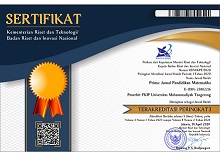DESIGNING LEARNING ROTATION USING THE CONTEXT OF BAMBOO WOVEN MOTIF
Abstract
An essential part of learning transformation geometry is rotation. Before learning more about other parts of the transformation geometry topic, such as translation, dilation, and reflection, firstly, students are required to understand well about rotation. However, several students have not been able to understand this subject properly due to the stages of learning in the rotation has not been appropriately arranged. Thus, this study aims to design a student learning trajectory in learning rotation, which develop from informal to formal level through the Indonesian Realistic Mathematics Education (IRME) approach. Furthermore, researchers used a design research method divided into three stages, namely preliminary design, design experiments, and retrospective analysis. This study describes how the bamboo woven motif contributes significantly to 31 ninth-grade students understanding the rotation concept. As a result, the woven bamboo motif's context can stimulate students' understanding of rotation. It is proven based on the strategies and models of students during their learning process which contributes to their fundamental knowledge of rotation.
Keywords
Full Text:
PDFReferences
Adams, K. D., & Cook, A. M. (2017). Performing mathematics activities with non-standard units of measurement using robots controlled via speech-generating devices: Three case studies. Disability and Rehabilitation: Assistive Technology, 12(5), 491-503.
Arisetyawan, A., Suryadi, D., Herman, T., & Rahmat, C. (2014). Study of Ethnomathematics: A lesson from the Baduy Culture. International Journal of Education and Research, 2(10), 681-688.
Clarke, D., & Roche, A. (2018). Using contextualized tasks to engage students in meaningful and worthwhile mathematics learning. The Journal of Mathematical Behavior, 51, 95-108.
Cobb, P., & Gravemeijer, K. (2006). Educational Design Research. London: Routledge.
Edo, S. I., Hartono, Y., & Putri, R. I. I. (2013). Investigating secondary school students’ difficulties in modeling problems PISA-model level 5 and 6. Journal on Mathematics Education, 4(1), 41-58.
Lestariningsih, & Mulyono, I. (2017). Desain pembelajaran transformasi menggunakan motif batik tulis Sidoarjo. Jurnal Edukasi, 3(1), 83-98.
Lestariningsih, Putri, R. I. I., & Darmawijoyo. (2015). The legend of Kemaro island for supporting students in learning average. Journal on Mathematics Education, 3(2), 165-174.
Maryati, & Prahmana, R. C. I. (2019). Ethnomathematics: Exploration of the Muntuk community. International Journal of Scientific & Technology Research, 8(06), 47-49.
Naidoo, J. (2012). Teacher reflection: The use of visual tools in mathematics classrooms. Pythagoras, 33(1), 1-9.
Prahmana, R. C. I. (2017). Design Research (Teori dan Implementasinya: Suatu Pengantar). Jakarta: Rajawali Pers.
Prahmana, R. C. I., Zulkardi, & Hartono, Y. (2012). Learning multiplication using Indonesian traditional game in third grade. Journal on Mathematics Education, 3(2), 115-132.
Revina, S., & Leung, F. K. S. (2019). How the same flowers grow in different Soils? The implementation of realistic mathematics education in Utrecht and Jakarta classrooms. International Journal of Science and Mathematics Education, 17(3), 565-589.
Risdiyanti, I., & Prahmana, R. C. I. (2018). Desain hypothetical learning trajectory dalam pembelajaran rotasi menggunakan motif batik Kawung. Prima: Jurnal Pendidikan Matematika, 2(1), 19-32.
Risdiyanti, I., & Prahmana, R. C. I. (2020). The learning trajectory of number pattern learning using "Barathayudha" war stories and uno stacko. Journal on Mathematics Education, 11(1), 157-166.
Sembiring, R. K., Hadi, S., & Dolk, M. (2008). Reforming mathematics learning in Indonesian classrooms through RME. ZDM - International Journal on Mathematics Education, 40(6), 927-939.
Stacey, K. (2011). The PISA view of mathematical literacy in Indonesia. Journal on Mathematics Education, 2(2), 95-126.
Zulkardi. (2013). Designing joyful and meaningful new school mathematics using Indonesian realistic mathematics education. Southeast Asian Mathematics Education Journal, 3(1), 17-25.
DOI: http://dx.doi.org/10.31000/prima.v4i2.2600
Article Metrics
Abstract - 1447 PDF - 991Refbacks
- There are currently no refbacks.
Prima: Jurnal Pendidikan Matematika
Program Studi Pendidikan Matematika
Fakultas Keguruan dan Ilmu Pendidikan
Universitas Muhammadiyah Tangerang
Jl. Perintis Kemerdekaan I/33, Cikokol
Kota Tangerang, Indonesia
e-mail: primajpm@gmail.com
Prima: Jurnal Pendidikan Matematika (p-ISSN: 2579-9827 | e-ISSN: 2580-2216) is licensed under a Creative Commons Attribution 4.0 International License.







